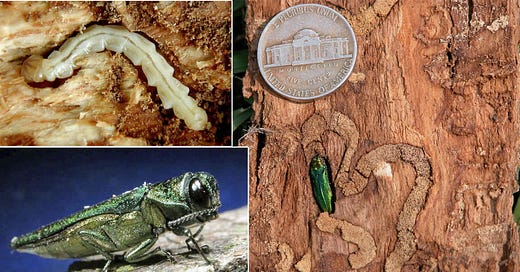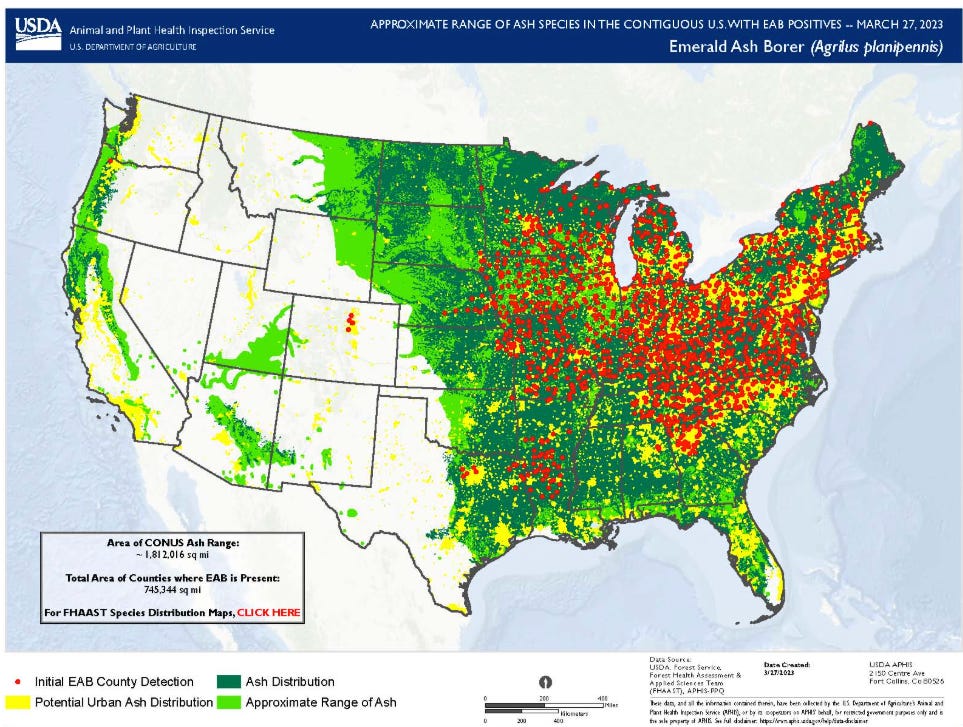MOUNT DESERT, May 22, 2025 - An invasive beetle which kills ash trees has been detected on Mount Desert Island.
The emerald ash borer (EAB), Agrilus planipennis, is an invasive beetle native to northeastern Asia that has caused significant ecological and economic damage across North America since it was first detected near Detroit, Michigan, in 2002.
Key Facts:
Appearance: Adult beetles are metallic green and about 1/2 inch long. Larvae are white, flat, and feed under the bark of ash trees.
Host: Only affects ash trees (Fraxinus species).
Damage: Larvae burrow under the bark, feeding on the inner bark and disrupting the tree's ability to transport water and nutrients. This leads to tree death within 2–4 years of infestation.
Spread: EAB spreads both naturally and through human activity (e.g., moving infested firewood or nursery stock).
Geographic Reach: As of 2025, EAB has spread to most of the eastern and central United States and parts of Canada. It has killed hundreds of millions of ash trees.
Signs of Infestation:
Canopy thinning or dieback
D-shaped exit holes in the bark
Bark splitting
Epicormic shoots (new growth from the trunk)
Woodpecker activity (they feed on the larvae)
Management:
Preventative insecticide treatments: Effective if applied early.
Biological control: Introduction of natural enemies (parasitoid wasps from Asia).
Quarantines and restrictions: Limit the movement of ash wood and firewood.
Removal and replacement: Dead or dying ash trees are removed and often replaced with other species.
🪲 How to Identify an EAB Infestation
Detecting an EAB infestation early is crucial for management. Look for the following signs on ash trees:Wikipedia+9burnsvillemn.gov+9Purdue Ag College+9
D-shaped exit holes: Approximately 1/8 inch wide, these holes are created by emerging adult beetles.
S-shaped galleries: Larvae feed under the bark, leaving serpentine tunnels.
Bark splitting: Vertical cracks may appear as the tree reacts to larval feeding.
Crown dieback: Thinning or dying branches, especially in the upper canopy.
Epicormic shoots: Sprouting of new branches from the trunk or base of the tree.
Increased woodpecker activity: These birds feed on EAB larvae, often leaving behind noticeable damage. Wisconsin DNR+1vtinvasives.org+1Invasive Species Centre+1Maryland Department of Natural Resources+1Maryland Department of Natural ResourcesWikipedia
For a visual guide on identifying EAB and its signs, you can watch the following video:
🛡️ Management and Prevention
If you suspect an EAB infestation:treetechinc.net
Report it: Contact the Maine Forest Service or use their online reporting tools to notify authorities.
Avoid moving firewood: Transporting firewood can spread EAB to new areas.
Consider treatment: Insecticide treatments can be effective, especially when applied before significant infestation.
Stay informed: Regularly check updates from local forestry departments and the Maine EAB Information Page for the latest guidelines and resources.Texas AgricultureMaine+1Maine+1
Maine Forest Service (MFS) Forest Health and Monitoring Division stated that “EAB continues to spread throughout Maine, and we appreciate the vigilance of local arborists and community members. Public awareness is important to detecting and responding to this destructive forest pest.”
As a result of this detection, the Maine Department of Agriculture Conservation and Forestry will expand the current EAB quarantine to include all towns on MDI. This non-contiguous quarantine may help slow the spread.
Key guidance for landowners, municipalities, and the public includes:
Ash tree material should remain on MDI. Logs, branches, or wood waste from removed trees should be disposed of on-site or at an island-based disposal facility.
Ash chips are not regulated and may be legally transported off the island.
High-value ash trees that are not heavily infested can be evaluated and may be preserved through systemic insecticide treatment by licensed pesticide applicators. These treatments require periodic reapplication.
Infested ash trees will decline quickly and become structurally unstable. Property owners and managers are urged to evaluate ash trees near infrastructure for potential treatment or removal.
Please let MFS know— If you suspect you have found damage from EAB in Maine, refer to www.maine.gov/eab. This website features an interactive map with EAB detections, quarantine boundaries, and tools for identification and reporting.
For more information and updated quarantine maps, visit www.maine.gov/eab and these resources:
APCAW: https://umaine.edu/apcaw/
SAP-Ne: https://foreststewardsguild.org/sustaining-ash-partners-network-sapne/
USDA APHIS PPQ: https://www.aphis.usda.gov/plant-pests-diseases/eab
USDA Forest Service State, Private and Tribal Forestry: https://www.fs.usda.gov/about-agency/state-private-tribal-forestry





It seems like a battle that the invasive bugs are going to win, similar to the worms I've been hearing about. I wonder what will happen to the bugs after they run out of food, will they die off allowing the ash trees to come back?
Every ash tree in Pa is dead. That 5-8% of our trees.